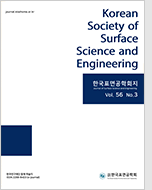
- Past Issues
- e-Submission
-

2021 Impact Factor 1.766
5-Year Impact Factor 1.674
Editorial Office
- +82-2-563-0935
- +82-2-558-2230
- submission@kssse.or.kr
- https://www.kssse.or.kr/

2021 Impact Factor 1.766
5-Year Impact Factor 1.674
The Korean Society of Surface Science and Engineering 2024;57(4):325-330. Published online: Sep, 9, 2024
DOI : 10.5695/JSSE.2024.57.4.325
When seawater is used in electrochemical devices, issues arise such as the adsorption of chloride ions blocking the active sites for Oxygen reduction reactions (ORR) in seawater batteries, and the occurrence of Chlorine evolution reactions (ClER) in seawater electrolysis due to chloride anions (Cl-) competing with OH- for catalytic active sites, potentially slowing down Oxygen evolution reactions (OER). Consequently, the performance of components used in seawater battery and seawater electrolysis may deteriorate. Therefore, conventional alloys are often used by coating or plating methods to minimize corrosion, albeit at the cost of reducing electrical conductivity. This study thus designed a corrosion-resistant layer by doping carbon with Nitrogen (N) and Sulfur (S) to maintain electrical conductivity while preventing corrosion. Optimal N,S doping ratios were developed, with corrosion experiments confirming that N,S (10:90) carbon exhibited the best corrosion resistance performance.
Keywords Seawater; Chloride evolution reaction; Corrosion-resistant layer; N,S doping; Carbon